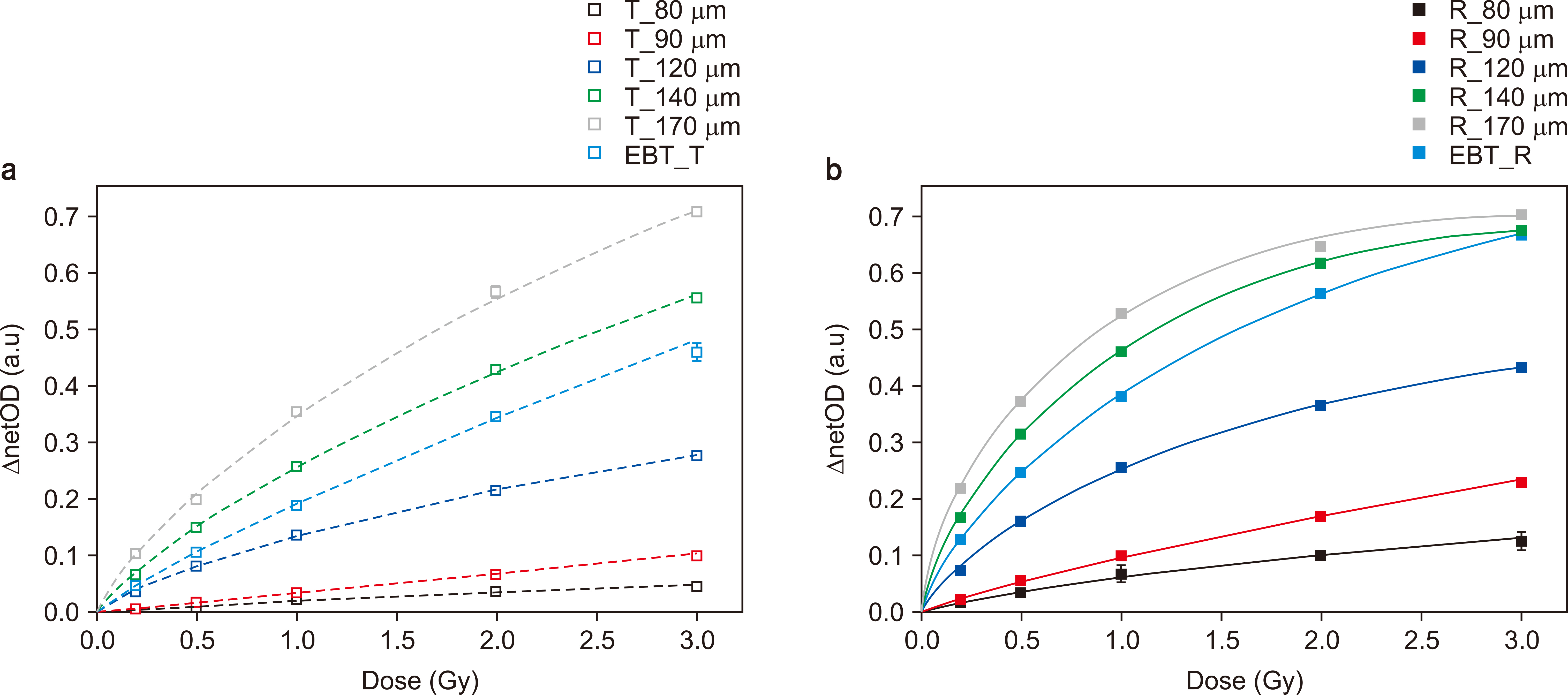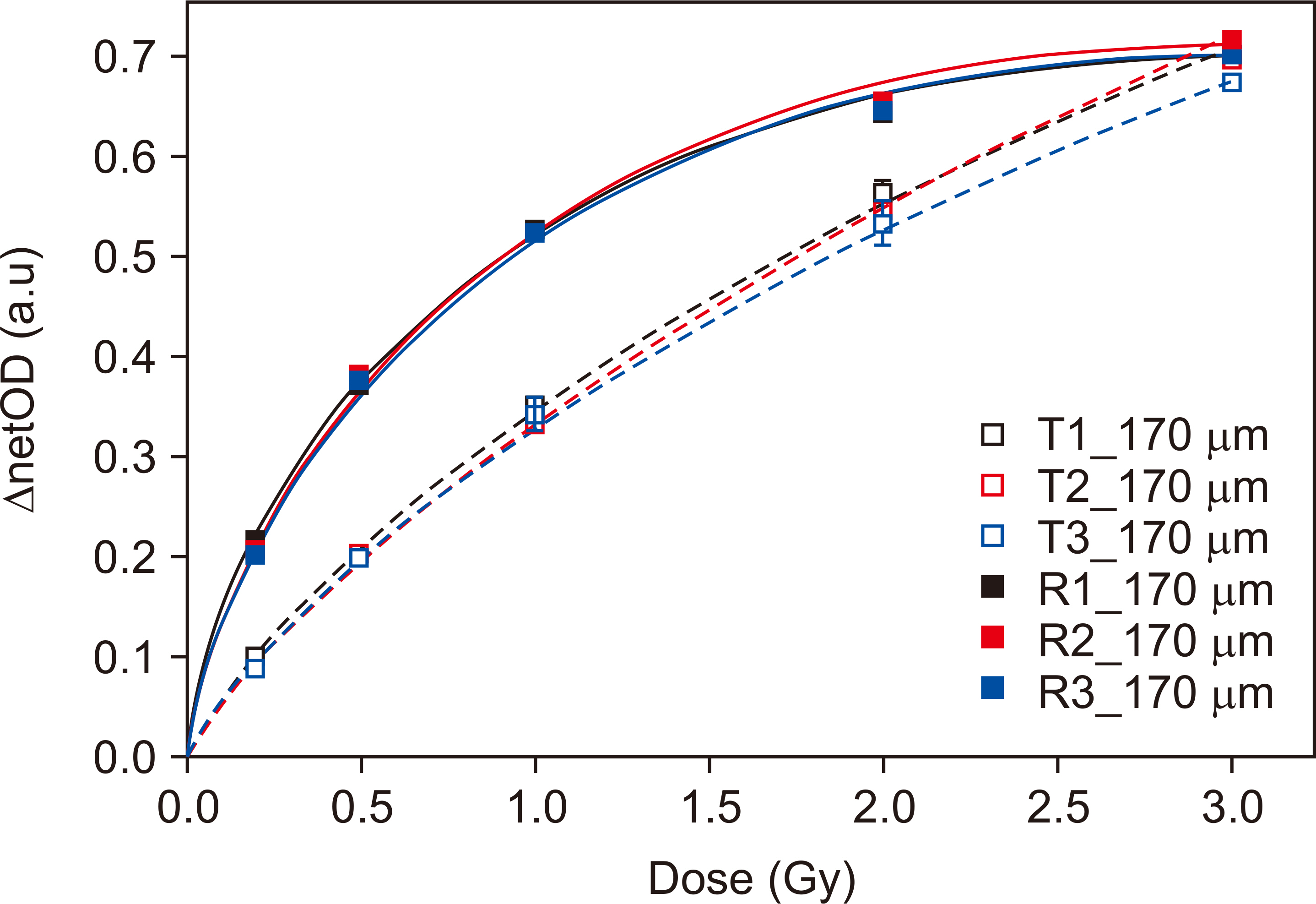Prog Med Phys.
2021 Dec;32(4):179-184. 10.14316/pmp.2021.32.4.179.
Dosimetric Characteristics of Flexible Radiochromic Film Based on LiPCDA
- Affiliations
-
- 1Department of Radiation Oncology, Seoul National University Hospital, Seoul, Korea
- 2Department of Radiation Oncology, Yonsei University College of Medicine, Seoul, Korea
- 3Institute of Radiation Medicine, Seoul National University Medical Research Center, Seoul, Korea
- 4Biomedical Research Institute, Seoul National University Hospital, Seoul, Korea
- 5Department of Radiation Oncology, Seoul National University College of Medicine, Seoul, Korea
- 6Robotics Research Laboratory for Extreme Environments, Advanced Institute of Convergence Technology, Suwon, Korea
- KMID: 2524166
- DOI: http://doi.org/10.14316/pmp.2021.32.4.179
Abstract
- This study aimed to determine the optimal thickness of the active layer and scan mode for a flexible radiochromic film (F-RCF) based on the active lithium salt of pentacosa-10,12-diynoic acid (LiPCDA). F-RCFs of 90, 120, 140, and 170-μm thickness were fabricated using LiPCDA. Several pieces of the F-RCFs were exposed to doses ranging from 0 to 3 Gy. Transmission and reflection modes were used to scan the irradiated F-RCFs. Their dose-response curves were obtained using a second-order polynomial equation. Their sensitivity was evaluated for both scanning modes, and the uniformity of the batch was also examined. For both the transmission and reflection modes, the sensitivity increased as the film thickness increased. For the reflection mode, the dose response increased dramatically under 1 Gy. The value of the net optical density varied rapidly as the thickness of the film increased. However, the dose-response curves showed a supralinear-curve relationship at doses greater than 2 Gy. The sensitivity of the reflection scan at doses greater than 2 Gy was higher than that of the reflection scan within 0–2 Gy. The sensitivity steadily decreased with increasing doses, and the sensitivity of the two modes was within 0.1 to 0.2 at 2 Gy and was saturated beyond that. For the transmission scan, the sensitivity was approximately 0.2 at 3 Gy. For the intra-batch test result, the maximum net optical density difference of the intra-batch was 5.5% at 2 Gy and 7.4% at 0.2 Gy in the transmission and reflection scans, respectively. In the low-dose range, film thickness of more than 120-μm was proper in the transmission mode. In contrast, the transmission mode showed a better result compared to the reflection mode. Therefore, the proper scan mode should be selected according to the dose range.
Keyword
Figure
Reference
-
References
1. Chu RDH, Van Dyk G, O'Hara KPJ, Buckland BW, Lewis DF, Dinelle F. 1990; GafChromicTM Dosimetry Media: a new high dose, thin film routine dosimeter and dose mapping tool. Radiat Phys Chem. 35:767–773. DOI: 10.1016/1359-0197(90)90313-7.
Article2. Collins C, Yoon SW, Kodra J, Coakley R, Subashi E, Sidhu K, et al. 2019; An investigation of a novel reusable radiochromic sheet for 2D dose measurement. Med Phys. 46:5758–5769. DOI: 10.1002/mp.13798. PMID: 31479518.
Article3. Casanova Borca V, Pasquino M, Russo G, Grosso P, Cante D, Sciacero P, et al. 2013; Dosimetric characterization and use of GAFCHROMIC EBT3 film for IMRT dose verification. J Appl Clin Med Phys. 14:4111. DOI: 10.1120/jacmp.v14i2.4111. PMID: 23470940. PMCID: PMC5714357.4. McLaughlin WL, Yun-Dong C, Soares CG, Miller A, Van Dyk G, Lewis DF. 1991; Sensitometry of the response of a new radiochromic film dosimeter to gamma radiation and electron beams. Nucl Instrum Methods Phys Res. 302:165–176. DOI: 10.1016/0168-9002(91)90506-L.
Article5. Rink A, Lewis DF, Varma S, Vitkin IA, Jaffray DA. 2008; Temperature and hydration effects on absorbance spectra and radiation sensitivity of a radiochromic medium. Med Phys. 35:4545–4555. DOI: 10.1118/1.2975483. PMID: 18975701. PMCID: PMC2736758.
Article6. Nakano M, Hill RF, Whitaker M, Kim JH, Kuncic Z. 2012; A study of surface dosimetry for breast cancer radiotherapy treatments using Gafchromic EBT2 film. J Appl Clin Med Phys. 13:3727. DOI: 10.1120/jacmp.v13i3.3727. PMID: 22584169. PMCID: PMC5716557.
Article7. Cho JD, Son J, Sung J, Choi CH, Kim JS, Wu HG, et al. 2020; Flexible film dosimeter for in vivo dosimetry. Med Phys. 47:3204–3213. DOI: 10.1002/mp.14162. PMID: 32248523.8. Setilo I, Du Plessis FCP. 2016; Dosimetric comparison between XR-RV3 and EBT2 radiochromic film in megavoltage photon beams. Int J Radiat Res. 14:149–152. DOI: 10.18869/acadpub.ijrr.14.2.149.
Article9. Andrés C, del Castillo A, Tortosa R, Alonso D, Barquero R. 2010; A comprehensive study of the Gafchromic EBT2 radiochromic film. A comparison with EBT. Med Phys. 37:6271–6278. DOI: 10.1118/1.3512792. PMID: 21302783.
Article10. Devic S, Seuntjens J, Sham E, Podgorsak EB, Schmidtlein CR, Kirov AS, et al. 2005; Precise radiochromic film dosimetry using a flat-bed document scanner. Med Phys. 32(7Part1):2245–2253. DOI: 10.1118/1.1929253.
Article11. Papaconstadopoulos P, Hegyi G, Seuntjens J, Devic S. 2014; A protocol for EBT3 radiochromic film dosimetry using reflection scanning. Med Phys. 41:122101. DOI: 10.1118/1.4901308. PMID: 25471974.
Article12. Kim JI, Cho JD, Son J, Choi CH, Wu HG, Park JM. 2020; Contact lens-type ocular in vivo dosimeter for radiotherapy. Med Phys. 47:722–735. DOI: 10.1002/mp.13932. PMID: 31743441.
- Full Text Links
- Actions
-
Cited
- CITED
-
- Close
- Share
- Similar articles
-
- Performance Optimization on the Sensitivity and Uniformity of the LiPCDA Film
- Evaluation of the Radiochromic Film Dosimetry for a Small Curved Interface
- Development of Flexible Amorphous Silicon Thin-Film Solar Cell-based Real Time Dosimetry System for Therapeutic X-ray
- Dosimetric Characteristics of Dynamic Wedge Techinique
- Feasibility Study of Utilizing a Portable Spectrophotometer to Assess the Radiation Dose Delivered to the Radiochromic Film




